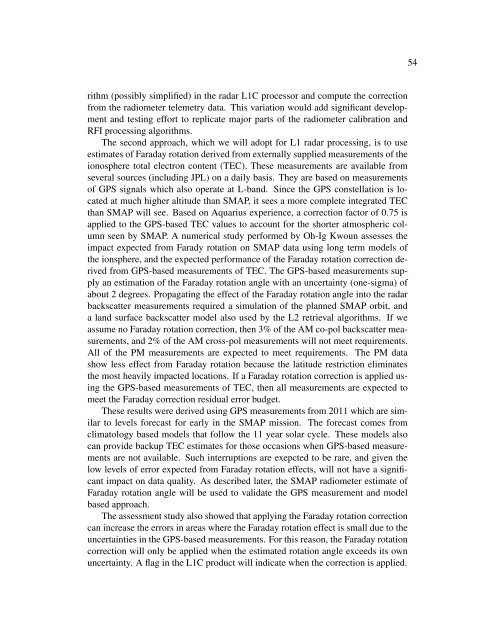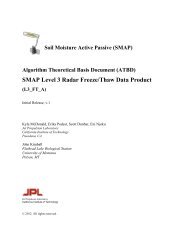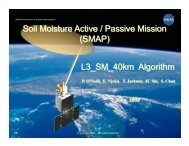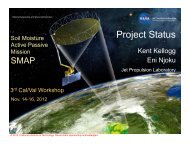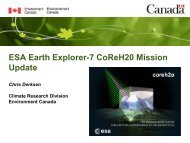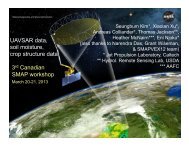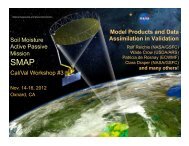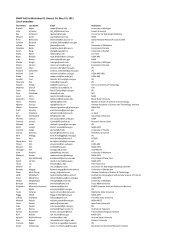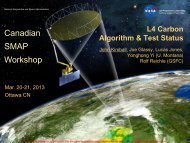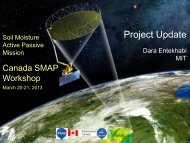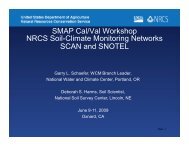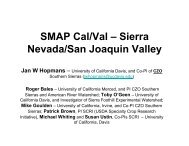(ATBD) SMAP Level 1 Radar Data Products - NASA
(ATBD) SMAP Level 1 Radar Data Products - NASA
(ATBD) SMAP Level 1 Radar Data Products - NASA
Create successful ePaper yourself
Turn your PDF publications into a flip-book with our unique Google optimized e-Paper software.
ithm (possibly simplified) in the radar L1C processor and compute the correction<br />
from the radiometer telemetry data. This variation would add significant development<br />
and testing effort to replicate major parts of the radiometer calibration and<br />
RFI processing algorithms.<br />
The second approach, which we will adopt for L1 radar processing, is to use<br />
estimates of Faraday rotation derived from externally supplied measurements of the<br />
ionosphere total electron content (TEC). These measurements are available from<br />
several sources (including JPL) on a daily basis. They are based on measurements<br />
of GPS signals which also operate at L-band. Since the GPS constellation is located<br />
at much higher altitude than <strong>SMAP</strong>, it sees a more complete integrated TEC<br />
than <strong>SMAP</strong> will see. Based on Aquarius experience, a correction factor of 0.75 is<br />
applied to the GPS-based TEC values to account for the shorter atmospheric column<br />
seen by <strong>SMAP</strong>. A numerical study performed by Oh-Ig Kwoun assesses the<br />
impact expected from Farady rotation on <strong>SMAP</strong> data using long term models of<br />
the ionsphere, and the expected performance of the Faraday rotation correction derived<br />
from GPS-based measurements of TEC. The GPS-based measurements supply<br />
an estimation of the Faraday rotation angle with an uncertainty (one-sigma) of<br />
about 2 degrees. Propagating the effect of the Faraday rotation angle into the radar<br />
backscatter measurements required a simulation of the planned <strong>SMAP</strong> orbit, and<br />
a land surface backscatter model also used by the L2 retrieval algorithms. If we<br />
assume no Faraday rotation correction, then 3% of the AM co-pol backscatter measurements,<br />
and 2% of the AM cross-pol measurements will not meet requirements.<br />
All of the PM measurements are expected to meet requirements. The PM data<br />
show less effect from Faraday rotation because the latitude restriction eliminates<br />
the most heavily impacted locations. If a Faraday rotation correction is applied using<br />
the GPS-based measurements of TEC, then all measurements are expected to<br />
meet the Faraday correction residual error budget.<br />
These results were derived using GPS measurements from 2011 which are similar<br />
to levels forecast for early in the <strong>SMAP</strong> mission. The forecast comes from<br />
climatology based models that follow the 11 year solar cycle. These models also<br />
can provide backup TEC estimates for those occasions when GPS-based measurements<br />
are not available. Such interruptions are exepcted to be rare, and given the<br />
low levels of error expected from Faraday rotation effects, will not have a significant<br />
impact on data quality. As described later, the <strong>SMAP</strong> radiometer estimate of<br />
Faraday rotation angle will be used to validate the GPS measurement and model<br />
based approach.<br />
The assessment study also showed that applying the Faraday rotation correction<br />
can increase the errors in areas where the Faraday rotation effect is small due to the<br />
uncertainties in the GPS-based measurements. For this reason, the Faraday rotation<br />
correction will only be applied when the estimated rotation angle exceeds its own<br />
uncertainty. A flag in the L1C product will indicate when the correction is applied.<br />
54


